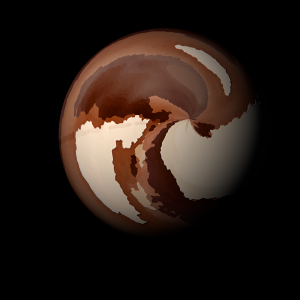|
|
Space Astro
|
Info for exoplanet "Odyhana"
| Scientific (actual) data |
|---|
| Planet | TOI-1634 c |
| Planet status | Confirmed |
| Orbital period | 103 |
| Orbit eccentricity | 0 |
| Discovered | 2022 |
| Updated | 2023-07-13 |
| Tperi | 2458900 |
| K | 3.51 |
| Publication | Published in a refereed paper |
| Detection type | Radial Velocity |
| Star name | TOI-1634 |
| Right ascension | 56.39° |
| Declination | 37.11° |
| Mag v | 13.2 |
| Star distance | 35.274 |
| Star metallicity | 0.23 |
| Star mass | 0.502 |
| Star radius | 0.45 |
| Star sp type | M2 |
| Star temperature | 3550 |
| Wikipedia article | TOI-1634 c |
Back
| |
| Fictional info (?) |
|---|
| Suggested name | Odyhana |
| Planet type | Cold planet |
| Odyhana is similar in composition to Uqux, and both have different bulk chemical composition from that of the larger cold planets. This planet is named after the deity Odyhana, the bringer of the underworld.
When viewed from Uqux, this proximity to TOI-1634 means the planet can only be seen near the western or eastern horizon during the early evening or early morning.
The atmospheric pressure at the planet's surface is 40 bar, or roughly the pressure found 1125 m under the oceans of Earth.
As the closest planet to Uqux, Odyhana has been a prime target for early interplanetary exploration. It was the one of the first exoplanets visited by a spacecraft, and one of the first to be successfully landed on. |
| Atmosphere | Ethane | 77% |
| Hydrogen | 21% |
| Molecular hydrogen | 1.5% |
| Helium | 0.022% |
| Hydrogen peroxide | 0% |
| Atmospheric pressure | 40 bar |
 |
| No known satellites |
| Google search for Odyhana |
|
Website by Joachim Michaelis
|
|
|
|